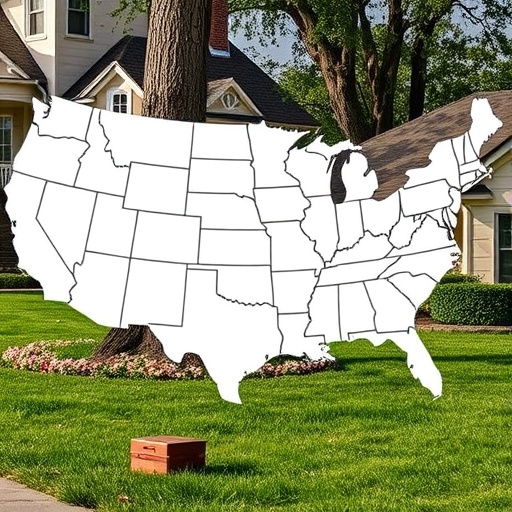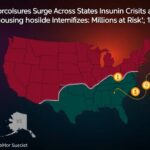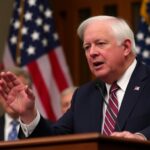Foreclosures Surge Across U.S.: Homeowners Grapple with Soaring Costs and Economic Pressures
In a stark reminder of economic fragility, Foreclosures in the United States have spiked by 23% in the first half of 2024 compared to the previous year, leaving thousands of families on the brink of losing their homes amid relentless rises in the cost of living. This surge, driven by inflation, higher interest rates, and stagnant wages, is not just a personal tragedy but a potential powder keg for the U.S. economy and the upcoming 2026 midterms.
Delinquency Rates Hit Record Highs in Swing States
The foreclosure crisis is hitting hardest in politically pivotal swing states, where mortgage delinquency rates have climbed to levels not seen since the 2008 financial meltdown. According to data from the Mortgage Bankers Association (MBA), states like Florida, Texas, and Pennsylvania reported delinquency rates exceeding 5% in Q2 2024, up from 4.1% a year ago. In Florida alone, foreclosure starts jumped 35%, fueled by a combination of hurricane recovery costs and skyrocketing property insurance premiums that have added hundreds to monthly bills.
Economists point to the housing market’s vulnerability as a key factor. Home values, while still elevated in many areas, are stagnating in suburban and rural regions where affordability was already stretched thin. ‘We’re seeing a perfect storm,’ said Dr. Elena Ramirez, a housing policy expert at the Urban Institute. ‘Rising costs for everything from groceries to utilities are squeezing middle-class families who locked in adjustable-rate mortgages during the low-interest era.’
This isn’t uniform across the country. Urban centers like New York and California show slightly lower increases, thanks to robust job markets in tech and finance, but even there, Foreclosures among lower-income brackets are up 15%. The ripple effects are evident: neighborhoods once bustling with community pride are now dotted with ‘For Sale’ signs and vacant properties, depressing local property values and straining municipal budgets for maintenance and policing.
Inflation and Interest Hikes Fuel Cost-of-Living Nightmare
At the heart of the foreclosure surge lies the unrelenting cost of living, which has eroded household budgets faster than wages can keep pace. The Consumer Price Index (CPI) for housing-related expenses rose 6.2% year-over-year in 2024, outpacing the overall inflation rate of 3.8%. For many homeowners, this translates to mortgage payments that have ballooned since the Federal Reserve’s aggressive rate hikes began in 2022, pushing the average 30-year fixed rate from under 3% to over 7%.
Take the case of the Johnson family in suburban Ohio, whose story mirrors thousands. In 2020, they bought a modest three-bedroom home with a 5/1 adjustable-rate mortgage. When rates reset in early 2024, their monthly payment jumped from $1,200 to $1,800— a 50% increase that coincided with grocery bills up 20% and energy costs soaring due to global supply disruptions. ‘We cut back on everything, but it wasn’t enough,’ Mrs. Johnson shared in an interview. ‘One missed payment, and the bank notices pile up.’
The U.S. economy, often touted for its resilience, is showing cracks under this pressure. The Federal Reserve’s latest report highlights that consumer debt, including mortgages, reached $17.5 trillion in Q1 2024, with subprime borrowers—those most at risk of foreclosure—accounting for a disproportionate share of new delinquencies. Experts warn that without intervention, this could lead to a broader slowdown, as foreclosed homes flood the market, further depressing prices and deterring new buyers. The National Association of Realtors estimates that a sustained foreclosure wave could shave 0.5% off GDP growth by 2025, amplifying concerns about recessionary risks.
- Key Cost Drivers: Food prices up 25% since 2021; utility bills increased 18%; healthcare costs rising 7% annually.
- Mortgage Impact: Over 2 million homeowners face rate resets in 2024-2025, per Freddie Mac data.
- Wage Stagnation: Median household income grew just 2.5% in 2023, far below inflation.
Government programs like forbearance extensions have helped some, but with federal aid drying up post-COVID, many are falling through the cracks. Advocacy groups are calling for renewed mortgage relief, arguing that the current system favors lenders over families.
Housing Market Teeters on the Edge of Collapse
The foreclosure uptick is sending shockwaves through the housing market, where inventory shortages have long propped up prices, but now risk tipping into oversupply in distressed areas. CoreLogic, a leading real estate analytics firm, reports that seriously delinquent mortgages—those 90+ days past due—now total 1.2 million, a 28% increase from 2023. This influx of foreclosed properties is already cooling buyer enthusiasm, with home sales down 12% nationally in the past quarter.
In markets like Las Vegas and Atlanta, once hotspots for investment, foreclosures are accelerating a shift from boom to bust. Investors who scooped up homes during the pandemic are now offloading at losses, wary of prolonged high rates. ‘The housing market is bifurcating,’ noted Mark Fleming, chief economist at First American Financial Corporation. ‘Affluent buyers in coastal cities continue snapping up luxury properties, while the middle market—where most foreclosures occur—is freezing up.’
This disparity exacerbates inequality in the U.S. economy. Low- and middle-income households, who make up 60% of recent foreclosure filings according to the CFPB, are losing equity built over years, widening the wealth gap. Community impacts are profound: schools in foreclosure-heavy districts report higher absenteeism and dropout rates, while local businesses suffer from reduced consumer spending. A study by the Brookings Institution links every 1% rise in foreclosures to a 0.3% drop in regional economic output, underscoring how housing woes cascade into broader stagnation.
Yet, glimmers of adaptation exist. Some states are piloting rent-to-own programs for foreclosed homes, and nonprofits like Habitat for Humanity are ramping up affordable housing initiatives. Still, without systemic fixes, the market’s volatility could persist, deterring the construction boom needed to ease supply constraints.
Political Storm Brewing Ahead of 2026 Midterms
As foreclosures mount, political analysts are sounding alarms about their potential to reshape the 2026 midterms, turning housing affordability into a flashpoint for voter discontent. With control of Congress hanging in the balance, Democrats and Republicans alike face backlash over policies perceived as ignoring the cost-of-living crisis. Polling from Pew Research shows 68% of Americans view housing costs as a top economic concern, up from 52% in 2022.
In battleground districts, the issue is visceral. A recent analysis by the Center for American Progress predicts that districts with foreclosure rates above 4% could swing 5-7% toward anti-incumbent sentiment, particularly in suburban areas where homeownership defines the American Dream. ‘This isn’t abstract policy; it’s families evicted on election day,’ warned Sen. Maria Gonzalez (D-CA), who has introduced a bill for expanded mortgage forgiveness. Her Republican counterpart, Rep. Tom Hargrove (R-TX), counters with calls for deregulation to boost housing supply, but both sides agree the status quo is untenable.
The midterms’ stakes are high for the U.S. economy. A divided Congress could stall relief measures, prolonging the pain. Voter turnout among affected demographics—young families and minorities, who face disproportionate foreclosure risks—could surge, altering turnout models. Historical parallels to 2008, when housing woes fueled Tea Party gains, suggest Republicans might capitalize on economic grievances, while Democrats push narratives of corporate greed in banking.
Campaign strategists are already adapting. Ads in key states highlight personal stories of foreclosure battles, framing the election as a referendum on economic stewardship. With the cost of living at the forefront, expect housing to dominate debates, potentially influencing everything from tax policy to Federal Reserve nominations.
Homeowner Resilience and Paths to Recovery
Amid the gloom, stories of resilience emerge, highlighting how homeowners are fighting back against the foreclosure tide. Organizations like the National Fair Housing Alliance report a 40% uptick in successful loan modifications in 2024, often through community-led workshops that teach negotiation tactics with lenders. In Michigan, a coalition of credit unions has forgiven $50 million in distressed mortgages, preventing 2,000 evictions and stabilizing neighborhoods.
Looking ahead, experts advocate for proactive measures to safeguard the housing market. The Biden administration’s proposed $10 billion in housing vouchers could provide immediate relief, while long-term solutions like zoning reforms aim to add 1 million affordable units by 2030. The Fed’s potential rate cuts in late 2024 offer hope, potentially lowering payments for millions and easing pressure on the U.S. economy.
However, the road to recovery is fraught. If foreclosures continue unchecked, they could trigger a vicious cycle of declining home values and reduced consumer confidence, hampering growth ahead of the midterms. Policymakers must act swiftly—expanding forbearance, incentivizing refinancing, and addressing root causes like wage inequality—to avert a deeper crisis. For families like the Johnsons, who recently secured a modification, these steps mean not just survival, but a chance to rebuild. As the nation watches, the foreclosure surge serves as a clarion call: fix the system, or face the consequences at the ballot box and beyond.








